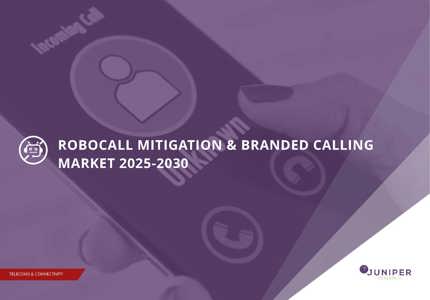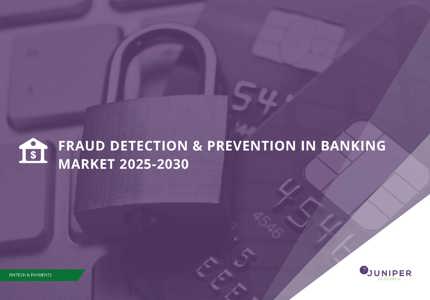Ofcom's New Scam Call Blocking Regulations: Implications for the UK Telecoms Market
Globally, there are a lack of comprehensive robocall mitigation frameworks from regulators. Leading regulatory bodies, for example, the FCC (Federation Communications Commission) in the US, have deployed initiatives such as STIR/SHAKEN (Secure Telephone Identity Revisited/Signature-based Handling of Asserted Information Using toKENs) and RMD (Robocall Mitigation Database) that aim to authenticate and verify caller ID information. The STIR/SHAKEN framework has been in operation for approximately five years in the US, whilst the RMD is yet to be fully deployed in the country. Despite this, there has been no reduction in subscribers’ fraudulent losses to robocalling to date in the US.
This highlights that even the most sophisticated robocalling mitigation solutions are not yet successfully protecting phone users, with over 50% of the total monetary losses to fraudulent robocalls being attributed to the US this year.
But the problem of fraudulent calls is not unique to the US, and the problem extends beyond fraudulent robocalls, which only consider automated telephone calls which deliver pre-recorded messages to a large number of recipients. Other examples include both AI and human-driven nuisance and scam calls relating to tax, bank, utility, lottery, and health-related calls, to name a few.
This week, the UK telecoms regulator, Ofcom, announced that it has given phone providers (including both fixed and mobile) six months to implement more stringent measures to protect users against these nuisance and scam calls, including its CLI (Call Line Identification) and Call for Input. Whilst most major mobile network and broadband providers in the UK have already shown proactivity in implementing such measures, these are not always effective, with over 129 million fraudulent robocalls being received by UK subscribers alone in 2024.
Figure 1: Total Number of Fraudulent Robocalls Received by Subscribers in the UK (m), 2020-2024.

Source: Juniper Research
In response, nuisance and scam call prevention measures are being deployed by phone providers in the UK. For example, in July 2024, EE launched its Scam Guard subscription, which charges an additional £1 a month to its subscribers to help protect them against online threats. The solution offers spam and scam call labelling, dark web monitoring, and free access to EE’s Cyber Security Duo for three months:
· Spam and Scam Call Labelling: Leverages an adaptive AI system to analyse aspects of a call in real-time to detect and notify subscribers of a potentially suspicious call.
· Dark Web Monitoring: Alerts the subscriber when their personal information, including bank card details and email login details, appear on the dark web.
· Cyber Security Duo: Offers real-time protection for up to two devices against viruses, malware and online threats. It also provides tools for strong password creation.
The aim of this Scam Guard solution is not only to protect EE subscribers against suspicious calls, but also to educate subscribers to better understand the technology they are using and what steps can be taken to better safeguard themselves.
However, in the UK telecoms market, the onus has not just been on the operators or broadband providers themselves to provide these scam and spam call mitigation solutions. Over the last six months, the UK government has been proactive in launching new national campaigns against online fraud. In February 2024, the UK government announced its ‘Stop! Think Fraud’ campaign, which leveraged advisory videos alongside a website with information on how to be protected from fraud. This campaign was part of a wider strategy launched by the UK government in May 2023 to stop scams and provide the public with an understanding on how to protect themselves against online and mobile scams. This was done by producing advice pages detailing scams to watch out for, including robocall fraud such as Wangiri fraud, number spoofing scams and coronavirus scam calls and texts.
Ofcom to Introduce Stricter Scam Call Blocking Initiatives
So, it seems that this latest announcement from Ofcom is the next step in its commitment to reduce fraudulent calls in the UK. But following this announcement, what is going to change?
Firstly, when considering an incoming call, there are generally two numbers associated with this call. These include the network number (where the call is being made from) and the presentation number (identifies who is making the call). In the majority of cases, these two numbers are the same, however, in some cases, for example when an outsourced call centre makes a call on behalf of a business, these numbers may be different.
With this, Ofcom is updating its CLI (Call Line Identification) guidance to extend call blocking to international calls, which display a UK number as a presentation number. This removes a potential loophole that historically allowed scammers to spoof a UK number from abroad. Whilst a number of telecoms providers such as BT have already implemented this voluntarily, Ofcom has given the UK industry until 29th January 2025 to implement this solution.
Secondly, Ofcom has requested feedback on some proposed changes to its Calls for Input guidelines. The proposed change will require operators to block calls from abroad with +447 numbers. However, this has significant implications for legitimate UK roamers. Whilst proposed technical solutions to this includes providing an international gateway provider that proactively undertakes checks and identifying mobile calls coming from abroad, it is anticipated that Ofcom will consult further in Spring 2025.
Branded Calling to Add Additional Strategy for Scam Call Mitigation
In the meantime, Juniper Research anticipates that brand verification will be a key strategy to prevent fraud over the next few years. Whilst the imminent launch of RCS (Rich Communication Services) on iOS will provide brand verification capabilities to reduce instances of messaging fraud, branded calling will also be implemented for consumers to have a trusted way of communicating with a brand via phone calls.
To instil trust in who is calling, strategies such as caller ID authentication have previously been used. Caller ID authentication ensures that the caller is who they say they are. Branded calling is a new form of caller ID whereby a business can choose to verify their identity by adding a logo and reason for the call to the display screen; helping individuals determine legitimate robocalls and improving success rates for businesses. Rather than attempting to block calls at the outset, branded calling provides a mechanism whereby consumers can identify legitimate calls themselves; hence instilling trust in the call and improving brand recognition.
Branded calling is an extension of CNAM (Caller ID Name), which added a display name to the caller ID for businesses when calling customers. However, CNAM was based off a decentralised infrastructure and had limited capabilities. The strategy was also spoofed by fraudsters. Therefore, branded calling was required to develop trust in legitimate robocalls; increasing the likelihood of them being answered by individuals.
Figure 2: Branded Calling versus CNAM

Source: Juniper Research
Whilst this is an initiative already being trialled in countries including the US, Juniper Research recognises that it must also be a key area of focus for mobile and broadband providers in the UK to reduce the frequency of successful fraudulent calls and scams against mobile subscribers.
Given the increased frequency and complexity of robocalls, UK stakeholders must develop a strategy focused on robocall mitigation techniques. Therefore, a collaborative approach between fraudulent mitigation vendors, mobile operators and regulators must be adopted to improve the success rate of fraud mitigation solutions. Ofcom’s involvement in demanding stakeholders to be more proactive with these measures is the first step in achieving a reduction in the number of fraudulent calls.
Latest research, whitepapers & press releases
-
 ReportDecember 2025
ReportDecember 2025AI Agents for Customer Experience Platforms Market: 2025-2030
Our comprehensive AI Agents for Customer Experience Platforms research suite comprises detailed assessment of a market that is set to disrupt mobile communications. It provides stakeholders with insight into the key opportunities within the AI agents for customer experience platforms market over the next two years.
VIEW -
 ReportDecember 2025Fintech & Payments
ReportDecember 2025Fintech & PaymentseCommerce Fraud Prevention Market: 2025-2030
Our eCommerce Fraud Prevention research suite provides a detailed and insightful analysis of this evolving market; enabling stakeholders from financial institutions, law enforcement agencies, regulatory bodies and technology vendors to understand future growth, key trends, and the competitive environment.
VIEW -
 ReportNovember 2025Telecoms & Connectivity
ReportNovember 2025Telecoms & ConnectivityeSIMs & iSIMs Market: 2025-2030
Juniper Research’s eSIMs and iSIMs research suite offers insightful analysis of a market set to experience significant growth in the next five years. The research suite provides mobile network operators (MNOs), original equipment manufacturers (OEMs), and eSIM management and platforms vendors with intelligence on how to capitalise on the market growth, and guidance on how eSIM-only devices and sensors, SGP.42, in-factory provisioning, and iSIMs will change the competitive landscape.
VIEW -
 ReportNovember 2025Fintech & Payments
ReportNovember 2025Fintech & PaymentsModern Card Issuing Platforms Market: 2025-2030
Our Modern Card Issuing Platforms Market research suite provides a detailed and insightful analysis of this evolving market; enabling stakeholders from banks, financial institutions, fintech companies, and technology vendors to understand future growth, key trends, and the competitive environment.
VIEW -
 ReportNovember 2025Fintech & Payments
ReportNovember 2025Fintech & PaymentsDigital Wallets Market: 2025-2030
Our digital wallets research suite provides detailed analysis of this rapidly changing market; allowing digital wallet providers to gain an understanding of key payment trends and challenges, potential growth opportunities, and the competitive environment.
VIEW -
 ReportOctober 2025Fintech & Payments
ReportOctober 2025Fintech & PaymentsDigital Identity Market: 2025-2030
Juniper Research’s Digital Identity research suite provides a comprehensive and insightful analysis of this market; enabling stakeholders, including digital identity platform providers, digital identity verification providers, government agencies, banks, and many others, to understand future growth, key trends, and the competitive environment.
VIEW
-
 WhitepaperDecember 2025Telecoms & Connectivity
WhitepaperDecember 2025Telecoms & ConnectivityHuman + AI: Drivers of Customer Experience AI Agents in 2026
Our complimentary whitepaper, Human + AI: Drivers of Customer Experience AI Agents in 2026, examines the key drivers of the AI agents for customer experience platforms market in 2025.
VIEW -
 WhitepaperDecember 2025Fintech & Payments
WhitepaperDecember 2025Fintech & PaymentsBeyond Chargebacks: The True Cost of Fraud for Digital Commerce
Our complimentary whitepaper, Beyond Chargebacks: The True Cost of Fraud for Digital Commerce, examines the state of the eCommerce fraud prevention market; considering the impact of evolving digital fraud strategies, including key trends such as identity theft, account takeovers, chargebacks, policy abuse and friendly fraud.
VIEW -
 WhitepaperNovember 2025Telecoms & Connectivity
WhitepaperNovember 2025Telecoms & ConnectivityeSIM-only Devices: The Impact on Operators, Consumers, and IoT
Our complimentary whitepaper, eSIM-only Devices: The Impact on Operators, Consumers, and IoT, explores the challenges and opportunities for the three segments, with a particular focus on eSIM-only smartphones and SGP.42.
VIEW -
 WhitepaperNovember 2025Fintech & Payments
WhitepaperNovember 2025Fintech & PaymentsUnlocking the Next Stage of Growth for Modern Card Issuing Platforms
This free whitepaper analyses key trends shaping the modern card issuing space, and the ways in which modern card issuing platforms can capture growth.
VIEW -
 WhitepaperNovember 2025Fintech & Payments
WhitepaperNovember 2025Fintech & PaymentsTop 10 Fintech & Payments Trends 2026
Fintech is evolving fast. From stablecoins to agentic AI, our annual guide reveals the shifts redefining payments, digital identity, and the future of money in 2026. Download your copy today.
VIEW -
 WhitepaperNovember 2025Fintech & Payments
WhitepaperNovember 2025Fintech & PaymentsDigital Wallets: Empowering Financial Inclusivity
Our complimentary whitepaper, Digital Wallets: Empowering Financial Inclusivity, examines the state of the digital wallets market; considering the impact of digital wallets on different geographies, how they are shaping the modern payments landscape through lower transaction fees and promoting financial inclusivity for underbanked populations, and how they are competing with established payment methods.
VIEW
-
IoT & Emerging Technology
Juniper Research Unveils Top 10 Emerging Tech Trends to Watch in 2026
January 2026 -
Fintech & Payments
Digital Identity App Usage to Hit 6.2 Billion by 2030, Driven by Shift to Decentralised Models
December 2025 -
Telecoms & Connectivity
Travel eSIM Margins Under Pressure as Revenue per Gigabyte Falls 10% Globally in Two Years
December 2025 -
Telecoms & Connectivity
AI Agents to Power 1,000% More Customer Interactions for Enterprises Globally by 2027
December 2025 -
IoT & Emerging Technology
Global D2C Revenue Set for $370 Million Surge, But Satellite Operators Should Not Chase Full MNO Status
December 2025 -
Fintech & Payments
Digital Goods Fraud to Cost eCommerce Merchants $27 Billion Globally by 2030 as AI Tools Accelerate Attacks
December 2025























